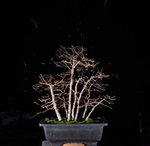In an effort to get this post back on track...I have a couple of thoughts.
Besides the conifer, I think the forest has quickly become one of my favorite bonsai subtypes. Living in St Louis, when I get outdoors, I'm often in deciduous forests. I'm finding inspiration everywhere!
Maybe the following is common knowledge, but for me, I've recently began to understand bonsai forests, at least, aesthetically better than before. So, indulge me for a second, then I'll circle back to the OPs original question.
When I first began building forests (from seedlings), I focused primarily on the following shape:
View attachment 279847
Which, is good. It offers the attempt at a scalene triangle that is important to bonsai design. But, what I missed, is that really good forest bonsai (IMO), offer another scalene triangle...
View attachment 279848
And that's created with the thickness of trunks. So when, the two come together, it's pleasing to the eye.
View attachment 279849
So, as I go about improving the forest that I have, I'm looking to introduce more trunk girth.
As I think about the next forest I want to create, I'm steering away from using all the same year seedlings and looking to find trees of varying ages.
The challenge I have for you,
@Adair M , is that you often will say something to the effect "I don't have time to develop X, so I'd rather purchase something that is farther along". (Which, btw, I whole heartily agree). But in the case of the forest you show, won't it take years to develop? And doesn't that go against your philosophy in other bonsai sub-types (conifers, for example)
For me, the next forest I build will be using stock from different ages of trees and it won't be using all seedlings. Nothing against the forest you bought, but who has time for those trunks to develop inside the bonsai pot? We buy age all the time, why don't we do the same with forests?





















